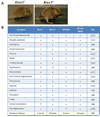Physiological consequences of defects in ERCC1-XPF DNA repair endonuclease
- PMID: 21612988
- PMCID: PMC3139823
- DOI: 10.1016/j.dnarep.2011.04.026
Physiological consequences of defects in ERCC1-XPF DNA repair endonuclease
Abstract
ERCC1-XPF is a structure-specific endonuclease required for nucleotide excision repair, interstrand crosslink repair, and the repair of some double-strand breaks. Mutations in ERCC1 or XPF cause xeroderma pigmentosum, XFE progeroid syndrome or cerebro-oculo-facio-skeletal syndrome, characterized by increased risk of cancer, accelerated aging and severe developmental abnormalities, respectively. This review provides a comprehensive overview of the health impact of ERCC1-XPF deficiency, based on these rare diseases and mouse models of them. This offers an understanding of the tremendous health impact of DNA damage derived from environmental and endogenous sources.
Copyright © 2011 Elsevier B.V. All rights reserved.
Figures

Similar articles
-
The ERCC1 and ERCC4 (XPF) genes and gene products.Gene. 2015 Sep 15;569(2):153-61. doi: 10.1016/j.gene.2015.06.026. Epub 2015 Jun 12. Gene. 2015. PMID: 26074087 Free PMC article. Review.
-
Mislocalization of XPF-ERCC1 nuclease contributes to reduced DNA repair in XP-F patients.PLoS Genet. 2010 Mar 5;6(3):e1000871. doi: 10.1371/journal.pgen.1000871. PLoS Genet. 2010. PMID: 20221251 Free PMC article.
-
DNA repair endonuclease ERCC1-XPF as a novel therapeutic target to overcome chemoresistance in cancer therapy.Nucleic Acids Res. 2012 Nov 1;40(20):9990-10004. doi: 10.1093/nar/gks818. Epub 2012 Aug 31. Nucleic Acids Res. 2012. PMID: 22941649 Free PMC article. Review.
-
Interstrand crosslink repair: can XPF-ERCC1 be let off the hook?Trends Genet. 2008 Feb;24(2):70-6. doi: 10.1016/j.tig.2007.11.003. Epub 2008 Jan 14. Trends Genet. 2008. PMID: 18192062 Review.
-
First reported patient with human ERCC1 deficiency has cerebro-oculo-facio-skeletal syndrome with a mild defect in nucleotide excision repair and severe developmental failure.Am J Hum Genet. 2007 Mar;80(3):457-66. doi: 10.1086/512486. Epub 2007 Jan 29. Am J Hum Genet. 2007. PMID: 17273966 Free PMC article.
Cited by
-
Exploiting the Microhomology-Mediated End-Joining Pathway in Cancer Therapy.Cancer Res. 2020 Nov 1;80(21):4593-4600. doi: 10.1158/0008-5472.CAN-20-1672. Epub 2020 Jul 10. Cancer Res. 2020. PMID: 32651257 Free PMC article. Review.
-
XPF activates break-induced telomere synthesis.Nat Commun. 2022 Oct 2;13(1):5781. doi: 10.1038/s41467-022-33428-0. Nat Commun. 2022. PMID: 36184605 Free PMC article.
-
Aging asymmetry: systematic survey of changes in age-related biomarkers in the annual fish Nothobranchius guentheri.Fish Physiol Biochem. 2017 Apr;43(2):309-319. doi: 10.1007/s10695-016-0288-1. Epub 2016 Sep 10. Fish Physiol Biochem. 2017. PMID: 27614442
-
Mouse Models of Accelerated Cellular Senescence.Methods Mol Biol. 2019;1896:203-230. doi: 10.1007/978-1-4939-8931-7_17. Methods Mol Biol. 2019. PMID: 30474850 Free PMC article.
-
Age-related dystrophic changes in corneal endothelium from DNA repair-deficient mice.Aging Cell. 2013 Dec;12(6):1122-31. doi: 10.1111/acel.12143. Epub 2013 Sep 1. Aging Cell. 2013. PMID: 23927039 Free PMC article.
References
-
- Petit C, Sancar A. Nucleotide excision repair: from E. coli to man. Biochimie. 1999;81:15–25. - PubMed
-
- Kuraoka I, Kobertz WR, Ariza RR, Biggerstaff M, Essigmann JM, Wood RD. Repair of an interstrand DNA cross-link initiated by ERCC1-XPF repair/recombination nuclease. J Biol Chem. 2000;275:26632–26636. - PubMed
-
- Schlake C, Ostermann K, Schmidt H, Gutz H. Analysis of DNA repair pathways of Schizosaccharomyces pombe by means of swi-rad double mutants. Mutat Res. 1993;294:59–67. - PubMed
Publication types
MeSH terms
Substances
Grants and funding
LinkOut - more resources
Full Text Sources

